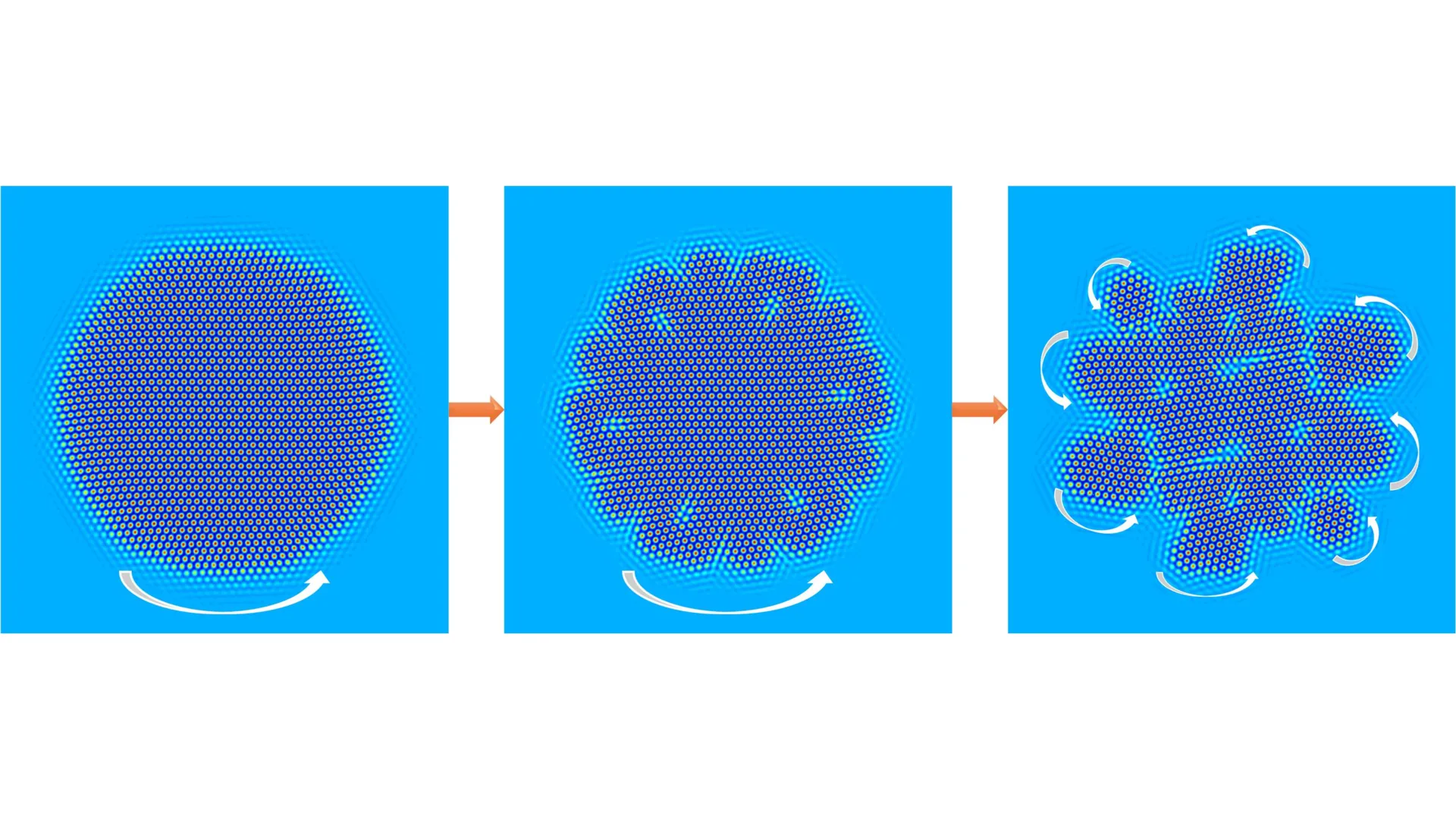Physicists discover strange spinning crystals that behave like living matter
Spinning crystals that twist, shatter, and rebuild themselves may hold the key to next-generation materials.
- Date:
- October 21, 2025
- Source:
- Heinrich-Heine University Duesseldorf
- Summary:
- Physicists have uncovered the fascinating world of “rotating crystals” — solids made of spinning particles that behave in strange, almost living ways. These odd materials can twist instead of stretch, shatter into fragments, and even reassemble themselves.
- Share:

It may sound unbelievable, but crystals made of rotating particles are real. A group of physicists from Aachen, Düsseldorf, Mainz, and Wayne State University (Detroit, USA) has explored these unusual materials and their remarkable behavior. These crystals can easily split into separate fragments, form unusual grain boundaries, and display controllable structural defects. In a study published in the Proceedings of the National Academy of Sciences (PNAS), the researchers present a broad theoretical framework that can predict several new properties of these so-called "transverse interaction" systems.
Rotating Systems in Nature and Technology
"Transverse forces" can appear not only in engineered materials, such as certain magnetic solids, but also in biological systems. In an experiment at the Massachusetts Institute of Technology (MIT), researchers observed that groups of starfish embryos, through their swimming motions, influenced each other's movement in a way that caused them to rotate around one another. The biological function of this coordinated motion remains unclear, but it shares the same fundamental feature found in these synthetic systems: interacting, rotating objects.
Professor Dr. Hartmut Löwen from the Institute of Theoretical Physics II at Heinrich Heine University Düsseldorf (HHU) explains: "A system of many rotating constituent elements exhibits a qualitatively new behavior that is non-intuitive: At high concentrations, these objects form a solid body of rotors, which possess 'odd' material properties."
One such property is known as "odd elasticity." Normally, when a material is pulled, it stretches along the direction of the force. In contrast, an odd elastic material does not stretch -- it twists instead.
Twisting, Breaking, and Reforming
This kind of "odd" solid can even disintegrate on its own. When the rotating building blocks rub together strongly enough, the solid can fragment into many smaller spinning crystallites. Even more surprisingly, these fragments can later reassemble themselves into a coherent structure once again.
A research team led by Professor Dr. Zhi-Feng Huang from Wayne State University and Professor Löwen developed a multiscale theoretical model to describe the behavior of these odd crystals. Using this model, they performed simulations that revealed unexpected patterns and possible technological uses for these rotating materials.
Reversing the Rules of Crystal Growth
The team found that large crystals governed by transverse interactions tend to break down into smaller spinning units, while smaller crystals grow until reaching a specific critical size. This outcome runs counter to conventional crystal growth, where materials typically expand steadily under favorable conditions.
Professor Huang explains:"We have discovered a fundamental property of nature underlying this process which determines the relation between the size of the critical fragments and their rotation speed."
Study co-author Professor Dr. Raphael Wittkowski of the DWI -- Leibniz Institute for Interactive Materials and of RWTH Aachen University, adds: "We furthermore demonstrated how defects in the crystals exhibit dynamics of their own. The formation of such defects can be influenced from outside, which allows properties of the crystals to be specifically controlled with a view to usage applications."
"Our far-reaching theory encompasses all systems evidencing such transverse interactions. Conceivable applications range from colloid research to biology," declares co-author Dr. Michael te Vrugt, Assistant Professor at the University of Mainz.
Professor Löwen adds: "The model calculations indicate concrete application potential. The novel elastic properties of these new crystals could be exploited to invent new technical switching elements, for example."
Central vs. Transverse Forces
In physics, interactions such as gravity and the Coulomb force are known as central forces because they act along the line connecting the centers of two bodies. These forces cause objects to move toward or away from each other.
By contrast, transverse interactions are a recently discovered class of forces that act perpendicular to that central axis. This unusual alignment causes the bodies to start rotating around one another spontaneously -- a dynamic at the heart of these newly discovered rotating crystals.
Story Source:
Materials provided by Heinrich-Heine University Duesseldorf. Note: Content may be edited for style and length.
Journal Reference:
- Zhi-Feng Huang, Michael te Vrugt, Raphael Wittkowski, Hartmut Löwen. Anomalous grain dynamics and grain locomotion of odd crystals. Proceedings of the National Academy of Sciences, 2025; 122 (42) DOI: 10.1073/pnas.2511350122
Cite This Page: